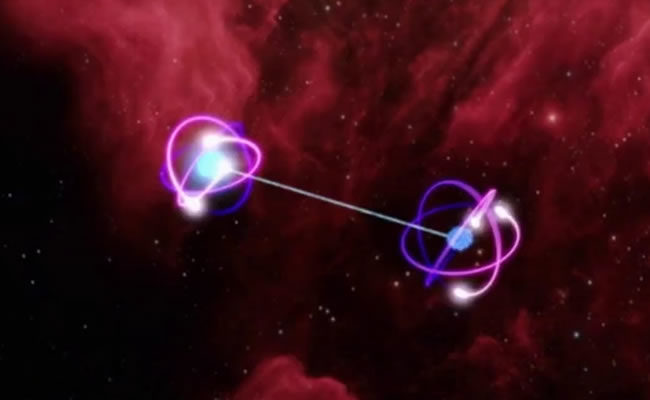IMT – QUANTUM ENTANGLEMENT
QUANTUM ENTANGLEMENT
When theories are right the pieces start falling into place. It is these markers that I look for to authenticate my ideas, and some of the markers for IMT are huge.
While looking at how IMT provides Quantum Gravity we saw that each particle has it’s antiparticle in the manifold.
We can also extend our understanding and, based on current quantum mechanics, expect, when it comes to quantum spin, the antiparticle is tidally locked to the matter particle.
The clue and the reciprocal explanation comes from Quantum Entanglement. When a particle is split into two and the spin of one particle is changed the other particle is also changed – instantly, and, it would seem, over any distance.
When we split a particle we aren’t adding any new energy into the system, so we can’t expect a new anti-particle to be created to match our new particle.
It is the intuitive to consider that both particles become tidally locked to the same anti-particle.
The new particle will, as indicated by quantum law, have an opposite spin to the original matter particle when it is created, but its spin will also be tidally locked to the antiparticle. So, when we change the original particles
spin, the anti-particle will change as well, this in-turn forcing the second bound particle to change it’s spin. Instantly.
While the two particles no longer seem bound in the matter universe, they are bound through their anti-matter counterpart.
SOMETHING UNEXPECTED
One of the most intriguing properties of the manifold is that it would appear, there is no time inside the manifold. This might seem like a huge leap, but the assumption is based on a number of observations that are outlined below.
In double slit experiments, adding detectors to the experiment changes the outcome. Moving the detectors to a point where detection is done after the photon hits the wall doesn’t change the fact that the detectors are there. Showing that entangled objects are not bound by time constraints.
IMT holds that Entanglement works due to a particle’s antiparticle living in the manifold, thus, if there is no time in the manifold then it doesn’t matter how far apart the two particles are, as the information is traveling in the manifold.
The double slit experiment proves this by removing time from the equation. The notion that an entangled particle will reflect it’s linked particles final state when tested makes sense. Since the particles are linked without the consideration of time, testing one particle will always reflect the final state of the associated particle.
The fact that there is no time in the manifold, a fact based on experiments with entangled particles, actually strengthens IMT and its construct.
LIMITATIONS
The jury is still out on how far quantum entanglement is viable, but using IMT we can answer the question and place an upper limit or max distance for the effect Einstein referred to as spooky action at a distance.
Based on the effective distance of the strong force and the Manifold Lensing Constant (mlc) from IMT we are able to determine the range of the strong force when it presents as gravity on the matter side of the manifold.
So if we consider the maximum distance between a particle and its anti-particle partner is equal to the field size of the strong nuclear force multiplied by mlc then the effective maximum range of Quantum Entanglement is the field size of the strong nuclear force multiplied by mlc times 2, with the antiparticle always maintaining a force balance in the middle of the two matter particles spatially.
This distance would vary slightly taking into account particle mass/energy. The practical use distance for quantum entanglement should also remain as the strong nuclear force multiplied by mlc times 2 since the effect is a quantum state and, a particle would either be entangled or not.
The particles gravitational reach, as provided by glc may also be used to determine the exact size of a solar system or structures in astrophysics.
The maximum distance for an outlying planet or satellite being somewhat less based on viable gravitation field strength.
